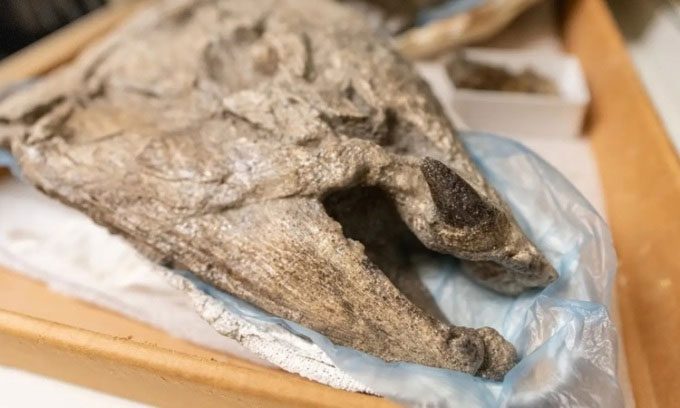The largest salmon species ever discovered is Oncorhynchus rastrosus, which could use its tusk-like teeth to compete with rivals, defend itself against predators, and dig nests.
Five million years ago, Oncorhynchus rastrosus, a prehistoric salmon species, reached lengths of up to 2.7 meters and weighed over 180 kilograms, inhabiting the waters of the northwestern coast of North America. They typically ambushed prey in the seas and rivers during the Miocene epoch. This species was nearly twice as long and over three times heavier than today’s largest salmon, the Chinook salmon. O. rastrosus also possessed a pair of fearsome forward-curving teeth resembling tusks, though they were not fangs. Researchers detailed the salmon O. rastrosus in the journal PLOS ONE on April 24, according to Popular Science.

Specimen of Oncorhynchus rastrosus with backward-growing tusks. (Photo: University of Oregon)
O. rastrosus was first described in 1972. At that time, scientists believed that the oversized backward-growing teeth resembled canines. As the largest member of the salmon family, they are commonly referred to as “tusked salmon” due to the positioning of their unique teeth. However, CT scans of some O. rastrosus fossils and analyses in the study confirmed that the two curved teeth, measuring 5 cm long, were similar to those of a walrus.
The research team is uncertain about the primary function of these distinctive tusks, but they speculate that they mainly helped in fighting off other salmon or predators. This could also be a method for females to dig nests for spawning or assist both sexes in swimming upstream to reproduce. “When swimming upstream, they might hook their tusks into something to rest without expending energy, similar to how you might grip a handrail at a swimming pool,” explained paleontologist Edward Davis from the University of Oregon.
According to professor Brian Sidlauskas, a fish specialist at the University of Oregon, these salmon likely did not use their teeth to catch prey. They may have been filter feeders consuming plankton. This could be one reason they grew to such enormous sizes. Their relatives, such as sockeye salmon, as well as basking sharks and whale sharks, all possess gill rakers to filter oxygen and microorganisms from the water. According to Davis, this giant salmon species had an unusually large number of gill rakers. The filter-feeding method might have contributed to their growth by allowing them to consume more organisms and obtain greater nutrients.
O. rastrosus also thrived in an environment with ample water and food resources supporting their large bodies. This giant salmon existed at the end of the Miocene epoch when the world’s oceans were much warmer than today. Global carbon dioxide levels were also nearing the threshold the Earth is expected to reach by 2100. Like salmon today, O. rastrosus hatched in freshwater, migrated to the ocean, and later returned to freshwater to spawn and die.
O. rastrosus became extinct as the Earth began to cool. This climate change likely eliminated the resources that the giant salmon needed to sustain their large bodies. In the future, Davis and colleagues plan to analyze some O. rastrosus specimens in more detail and explore how their tusks were utilized.


















































